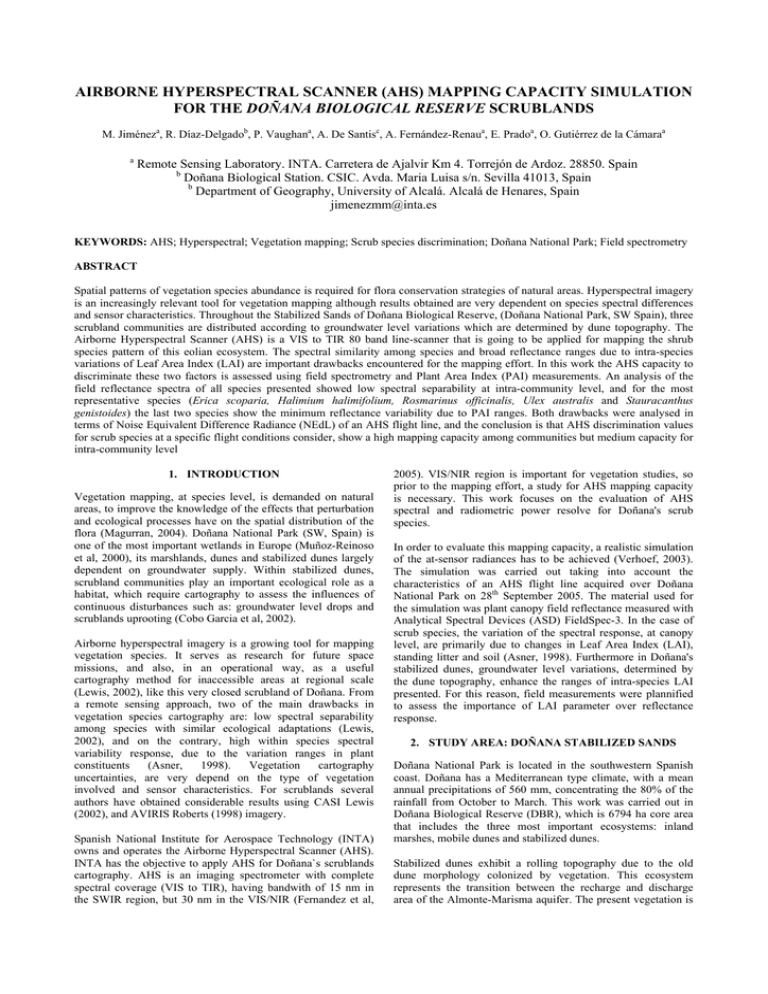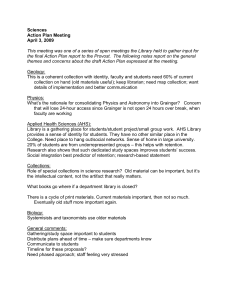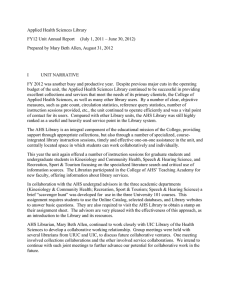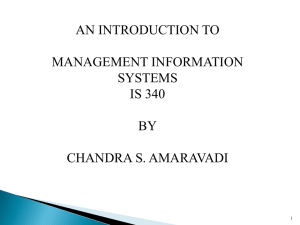AIRBORNE HYPERSPECTRAL SCANNER (AHS) MAPPING CAPACITY SIMULATION DOÑANA BIOLOGICAL RESERVE
advertisement

AIRBORNE HYPERSPECTRAL SCANNER (AHS) MAPPING CAPACITY SIMULATION FOR THE DOÑANA BIOLOGICAL RESERVE SCRUBLANDS M. Jiméneza, R. Díaz-Delgadob, P. Vaughana, A. De Santisc, A. Fernández-Renaua, E. Pradoa, O. Gutiérrez de la Cámaraa a Remote Sensing Laboratory. INTA. Carretera de Ajalvir Km 4. Torrejón de Ardoz. 28850. Spain b Doñana Biological Station. CSIC. Avda. Maria Luisa s/n. Sevilla 41013, Spain b Department of Geography, University of Alcalá. Alcalá de Henares, Spain jimenezmm@inta.es KEYWORDS: AHS; Hyperspectral; Vegetation mapping; Scrub species discrimination; Doñana National Park; Field spectrometry ABSTRACT Spatial patterns of vegetation species abundance is required for flora conservation strategies of natural areas. Hyperspectral imagery is an increasingly relevant tool for vegetation mapping although results obtained are very dependent on species spectral differences and sensor characteristics. Throughout the Stabilized Sands of Doñana Biological Reserve, (Doñana National Park, SW Spain), three scrubland communities are distributed according to groundwater level variations which are determined by dune topography. The Airborne Hyperspectral Scanner (AHS) is a VIS to TIR 80 band line-scanner that is going to be applied for mapping the shrub species pattern of this eolian ecosystem. The spectral similarity among species and broad reflectance ranges due to intra-species variations of Leaf Area Index (LAI) are important drawbacks encountered for the mapping effort. In this work the AHS capacity to discriminate these two factors is assessed using field spectrometry and Plant Area Index (PAI) measurements. An analysis of the field reflectance spectra of all species presented showed low spectral separability at intra-community level, and for the most representative species (Erica scoparia, Halimium halimifolium, Rosmarinus officinalis, Ulex australis and Stauracanthus genistoides) the last two species show the minimum reflectance variability due to PAI ranges. Both drawbacks were analysed in terms of Noise Equivalent Difference Radiance (NEdL) of an AHS flight line, and the conclusion is that AHS discrimination values for scrub species at a specific flight conditions consider, show a high mapping capacity among communities but medium capacity for intra-community level 1. INTRODUCTION Vegetation mapping, at species level, is demanded on natural areas, to improve the knowledge of the effects that perturbation and ecological processes have on the spatial distribution of the flora (Magurran, 2004). Doñana National Park (SW, Spain) is one of the most important wetlands in Europe (Muñoz-Reinoso et al, 2000), its marshlands, dunes and stabilized dunes largely dependent on groundwater supply. Within stabilized dunes, scrubland communities play an important ecological role as a habitat, which require cartography to assess the influences of continuous disturbances such as: groundwater level drops and scrublands uprooting (Cobo Garcia et al, 2002). Airborne hyperspectral imagery is a growing tool for mapping vegetation species. It serves as research for future space missions, and also, in an operational way, as a useful cartography method for inaccessible areas at regional scale (Lewis, 2002), like this very closed scrubland of Doñana. From a remote sensing approach, two of the main drawbacks in vegetation species cartography are: low spectral separability among species with similar ecological adaptations (Lewis, 2002), and on the contrary, high within species spectral variability response, due to the variation ranges in plant constituents (Asner, 1998). Vegetation cartography uncertainties, are very depend on the type of vegetation involved and sensor characteristics. For scrublands several authors have obtained considerable results using CASI Lewis (2002), and AVIRIS Roberts (1998) imagery. Spanish National Institute for Aerospace Technology (INTA) owns and operates the Airborne Hyperspectral Scanner (AHS). INTA has the objective to apply AHS for Doñana`s scrublands cartography. AHS is an imaging spectrometer with complete spectral coverage (VIS to TIR), having bandwith of 15 nm in the SWIR region, but 30 nm in the VIS/NIR (Fernandez et al, 2005). VIS/NIR region is important for vegetation studies, so prior to the mapping effort, a study for AHS mapping capacity is necessary. This work focuses on the evaluation of AHS spectral and radiometric power resolve for Doñana's scrub species. In order to evaluate this mapping capacity, a realistic simulation of the at-sensor radiances has to be achieved (Verhoef, 2003). The simulation was carried out taking into account the characteristics of an AHS flight line acquired over Doñana National Park on 28th September 2005. The material used for the simulation was plant canopy field reflectance measured with Analytical Spectral Devices (ASD) FieldSpec-3. In the case of scrub species, the variation of the spectral response, at canopy level, are primarily due to changes in Leaf Area Index (LAI), standing litter and soil (Asner, 1998). Furthermore in Doñana's stabilized dunes, groundwater level variations, determined by the dune topography, enhance the ranges of intra-species LAI presented. For this reason, field measurements were plannified to assess the importance of LAI parameter over reflectance response. 2. STUDY AREA: DOÑANA STABILIZED SANDS Doñana National Park is located in the southwestern Spanish coast. Doñana has a Mediterranean type climate, with a mean annual precipitations of 560 mm, concentrating the 80% of the rainfall from October to March. This work was carried out in Doñana Biological Reserve (DBR), which is 6794 ha core area that includes the three most important ecosystems: inland marshes, mobile dunes and stabilized dunes. Stabilized dunes exhibit a rolling topography due to the old dune morphology colonized by vegetation. This ecosystem represents the transition between the recharge and discharge area of the Almonte-Marisma aquifer. The present vegetation is remnant of the original sabinars (Juniperus phoenicea subs turbinata), umbrella pine plantations (Pinus pinea), some grasslands, but mostly a mosaic of three scrubland communities, composed of species described in table 1. Spatial distribution of scrubland is determined, at all scales, by the rolling topography that modulate the groundwater level (Muñoz-Reinoso et al, 2002). At regional scale highest zones, 40 - 50m above sea level, are dominated by sclerophyll xerophytic scrub (named locally “Monte Blanco”), for deeper zones, 0-20 m, hygrophytic scrub (named locally “Monte Negro”) is strongly developed. Transitions zones are colonized of a mixture community (named locally “Monte Intermedio”) composed of more adaptable species to a variable conditions of water stress. Scrub community "Monte Negro" Hygrophytic scrub "Monte Intermedio" Mixed scrub "Monte Blanco" Xerophytic scrub Species Erica scoparia (Es), Calluna vulgaris (Cv), Ulex minor (Um), Erica ciliaris (Ec) Halimium halimifolium (Hh), Ulex australis (Ua), Stauracanthus genistoides (Sg) Cistus libanotis (Cl), Rosmarinus officinalis (Ro), Halimium commutatum (Hc), Lavandula stoechas (Ls) Table 1: Representative scrub species in Doñana's stabilized dunes communities. Key to abbreviations. 3. MATERIAL 3.1 Airborne Hyperspectral Scanner (AHS) AHS NIR/SWIR NEDL (nW /cm2 sr nm) 30 25 20 15 10 5 0 1 4 7 10 13 16 19 22 25 28 31 34 37 40 43 46 49 52 55 58 61 AHS CHANNEL Figure 1: NIR/SWIR NEDL for the AHS flight-line simulated conditions. 3.2 Field spectroscopy campaigns Scrub reflectance spectra were measured during 2005 and 2006 dry seasons, when the phenological state (no floration) were similar for all species. Analytical Spectral Devices FiledSpec-3 (www.asdi.com) was used to record the reflectance of plants. ASD FieldSpec-3 is a portable spectroradiometer estimates target reflectance between 0.4 to 2.5 µm, using fiber optic (adaptable fore-optic devices). Two kind of measurements at canopy level were record with two different objectives: Type 1) with the aim to analyze species separability, a total of 200 spectra corresponding with 13 species, were collected. Three different zones in altitude over RBD were sampled, selecting plants with similar aspect in height, diameter and LAI within species. 15 spectra per specie were recorded, and for each plant 5 measures, the fiber optic of the spectrometer was held 1m (GIFOV=44 cm) above canopy in a nadir position. The AHS is an airborne line-scanner imaging spectrometer manufactured by ArgonST (formerly Sensytech Inc.). AHS Collets 80 bands form 0.45 to 12.8 microns inside atmospheric windows. It is installed onboard the INTA’s aircraft (CASA C212) and is integrated with INS/GPS Applanix POS-AV 414. The main characteristics of AHS could see in the table 2. FOV / IFOV : 90º / 2.5 mrad Scan rates: 12.5, 18.75, 25, 35 r.p.s., (pixel 7 to 2 meters). Digitization precision: 12 bits to sample the analog signal, with gain level from x0.25 to x10. Two controllable thermal black bodies within the field of view. PORT spectral nº of bands / λ/Δλ coverage(μm) FWHM (nm) (minimum) Port 1 Port 2A Port 2 Port 3 Port 4 0.43 > 1.03 1.55 > 1.75 2.0 > 2.54 3.3 > 5.4 8.2 > 12.7 20 / 28 nm 1 / 200 nm 42 / 13 nm 7 / 300 nm 10 / 400 nm 16 8 150 11 20 Table 2: AHS characteristics. 3.1.1 AHS data simulation conditions The flight line which is gone be simulated was acquired on 28th September 2005 at noon. The altitude was 1839 m above sea level and with scan rate of 18.5 rps which corresponds with a pixel of 4,5 m. The solar azimuth was 133 degrees and solar zenith 50 degrees. Figure 2: Upper: Averaged spectrum for canopy ASD scrub measurements. Bottom: Rosmarinus officinalis spectrum grouped for plant PAI variation. Type 2) to assess within species reflectance variability due to LAI variations, canopy plant measurement were carried out over dominant species of stabilized dunes (Erica scoparia, Halimium halimifolium, Ulex australis, Rosmarinus officinalis and Stauracantus genistoides). Here also 15 plants per specie were collected, in this case selecting individuals of low and high degrees of LAI. For each plant 5 measurements were recorded, the fiber optic of the spectrometer was held 1m (GIFOV=44 cm) above canopy in a nadir position. In parallel, for each plant measured, hemispherical canopy photography was taken from beneath upwards. To get this 180 degree field of view a NIKON FC-E8 fisheye lens was adapted to a Nikon 4000 Coolpix digital camera. Following protocols for field acquisition photographs were gathered at nearly sunset (Chen at al, 1997). 4. METHODOLOGY 4.1 Plant spectra analysis The entire set of plant spectra measured was pre-procesed applying: bad spectra elimination, convolution smoothed, averaged and standard deviation. Plant spectra average was extracted to a specie level file where, again, the average and standard deviation were calculated. These files were ENVI spectral library formatted (ITT Industries, Inc) 4.1.1 Spectra separability Using measurement type 1 spectra, the separabilty between all species was assessed in terms of the index Spectral Similarity Value (SSV) (Sweet, 2003). This index, equation 1, estimates the separation between spectra, taking into account shape aspects by correlation, and separation by euclidean distance. The SSV values range from 0 for a completely similarity to 1.4. SSV = D 2 + (1 − R 2 ) (1) Where: D = euclidean distance R = correlation coefficient 4.1.2 PAI reflectance variability Using spectra of field measurement type 2, the reflectance variability due to LAI increments was assessed for the most abundant species of each community. Considering scrub vegetation, canopy LAI variation has strong influence on his reflectance signatures, however woody stem is also very important (Asner, 1998). In this work, due to operative reasons, overall Plant Area Index (PAI) was obtained instead. PAI was calculated processing their corresponding hemispherical canopy photo with Hemiview 2.1 (Delta-T Devices, Ltd). This software estimates gap fraction over the entire photo and calculates the PAI. Only relative increments of PAI were the scope, so no absolute value was manage. All non-destructive field methods underestimate LAI canopy due to clumping effect (Asner 1998), in the case of hemispherical photo methodology, it has a good correlation with the LAI values obtained with Licor 2000 in a work realized by University of Valencia evaluating several crop types for ESA Sen2flex 2005 project (www.uv.es/leo/sen2flex). Scrub specie Erica scoparia (Es) Halimium halimifolium (Hh) Ulex australis (Ua) Rosmarinus officinalis (Ro) Stauracanthus genistoides (Sg) Min PAI 1.03 Max PAI 2.87 rP NIR 0.63 Cv NIR(%) 11 1.1 3.8 0.56 18 1.5 2.5 0.45 12 0.8 2.5 0.64 20 0.9 2 0.2 6 Table 3: Scrub PAI values obtained with hemispherical photo and some PAI spectra parameters for shrub species. Two parameters were estimated to evaluate the relation between spectral reflectance and PAI at species level: correlation (r Peason) and coefficient of variation (Cv). The parameters were calculated along wavelength but NIR region is the more related with quantity of leaf. Table 3 shows range values of PAI measured with hemispherical photo, and correlation and coefficient of variation for NIR region . For the dominant species consider, one standard deviation about the mean reflectance, was used as the criterion to determine species characteristic increment due to PAI ranges. This increment represents the signal level to be evaluated against AHS radiometric and spectral performance. 4.2 AHS mapping capacity simulation Species reflectance average and PAI increments characteristic was propagated to at-sensor radiance, at illumination and atmospheric conditions of the AHS flight line consider. AHS discrimination capacity for species discrimination and PAI increments, was assessed with their at-sensor radiances analyzing the spectral an radiometric power resolve. In this approach no consideration about spatial aspect was tucked into account, we assume a pixel cover entirely of the specie consider. 4.2.1 At-sensor radiance Plant reflectance was fed into a standard radiative transfer code, converting surface data into at-sensor radiances with the correspondence atmospheric and illumination conditions of the september AHS flight line. MODTRAN4 (Berk et al 2000) was used to calculate the at-sensor radiances from 400 to 2500 nm, we assumed no adjacency effect and also isotropic radiation. Figure 3: Halimium halimifolium (Mean ± 1SD) at- sensor radiance for AHS flight line conditions 4.2.2 AHS radiometric resolve AHS resolve the incoming signal with 12 bits of dynamic range, having independently channel programmable gain. The gain is set up depending on brightness conditions of ground surfaces, increasing the gain (see point 3.1) maximize the radiometric resolution, but reduce the saturation value. The radiometric resolution applied is not the final discriminate radiometric capacity because of the noise. Noise is the uninformation part of the signal and has multiple sources into and out of the sensor (atmosphere for example). A measurement that estimates the entire noise and the minimum signal discernible of the sensor is the Noise Equivalent Difference Radiance (NEDL), which is the signal with a signal-to-noise ratio of 1. Because of AHS is a mechanical scanner, AHS NEDL is function of the scan speed which image was gathered. The better spatial resolution the faster scan speed, then more NEDL is presented in the image. NEDL is also function of wavelength, in figure 1 the AHS NEDL for the flight-line for simulation is showed, calculated as the standard deviation of the BlackBody radiance registered in each line. 1.000 0.900 Ro 0.800 SSV separability Index Figure 3 shows the Halimium halimifolium average at-sensor radiance, plus ±1 standard deviation, propagated with MODTRAN4 for the AHS illumination and atmospheric flight line conditions. Clearly it can be seen the water opaque bands (null transmittance), and the high spectral resolution of the MODTRAN output. Hc Ls 0.700 Tm 0.600 Cl Hh 0.500 Sg Ua 0.400 Es 0.300 Cv pp 0.200 Arena 0.100 0.000 Ro Hc Ls Tm Cl Hh Sg Ua Es Cv Pp Arena Species Figure 4: SSV values for spectra shrub species of Doñana's communities. In order to evaluate if AHS can resolve the little radiometric differences between low separability species, on figure 5, the minimum and maximum separation found in at-sensor radiances values was plotted against AHS NEDL. The minimum was found between Ulex australis and Stauracanthus genistoides, and comparing with the NEDL of the AHS flight line, the difference is solved with enough capacity except for atmospheric absorptions regions in the VIS/NIR and in the final region of the SWIR. We have to had in mind that in the SWIR region an important factor for the spectral response of scrub is the presence of and litter and soil. 4.2.3 AHS spectral resolve At-sensor radiance mean spectra and PAI species characteristic increments, of each dominant scrub specie was resampled, weighting by the AHS channel spectral response function. These response functions are band characterize by a wavelength center and a bandwidth or Full Width Half Maximun (FWHM). The response functions were measured at INTA facility using a monochomator with 0.2 nm resolution. With the aim to evaluate the AHS spectral capacity for the discrimination of scrub species, the at-sensor radiances spectra were also resampled with the spectral configuration of the imaging spectrometrer HyMap manufactured by Integrated Spectronics Pty, Ltd (www.intspec.com). HyMap is a reference sensor for vegetation mapping, and acquires images from 0.4 to 2.500 microns having 128 bands with a mean of 15 nm of FWHM. In this cases spectral resampling was realized using the bandcenter and FWHM assuming gaussian function response. 5. RESULTS AND DISCUSSION Figure 4 shows the values retrieved with SSV algorithm among scrub species of the three communities, including as a reference the separability values of sand dune and Pinus Pinea. Very low separability values within community, show that spectral response between species of the same community are very similar in shape and distance. Species are well adapted to environmental conditions, so this behaviour is expected (Lewis, 2002). Furthermore, separability values between species of "Monte blanco" and "Monte Intermedio" are also very low (SSV nearly 0.3), indicating again similar adaptations of these two communities. Figure 5: Maximum and minimum spectral differences against AHS NEDL . As It can be seen in table 3, the relative PAI values, calculated with hemispherical photo, for the most abundant scrub species, has good correlation with the NIR reflectance (p< 0.05). This part of the spectrum is more related with foliar presence (Asner, 1998). The worst correlate species in the NIR was Stauracanthus genistoides and Ulex australis, both species has the ecological adaptation to accumulate non-photosynthetic biomass in the canopy. In the SWIR region, an elevated negative correlation was found due to the influence of litter and soil, see figure 2, in scrub canopy spectra. To evaluate if the AHS can resolve the variability in the canopy scrub response related with PAI variations, species increments characteristic in compared with the AHS NEDL. In figure 6 it can be seen that Stauracanthus genistoides and Ulex australis are again the species with the less increment, and it is difficult to discernable by AHS in the SWIR region due to the rise of the NEDL. 6. CONCLUSIONS The spectral separability of Doñana`s scrub species is high on an inter-community level, but very low on an intra-community level. For AHS flight line conditions consider the NEDL is sufficient to discriminate the minimum separability except for the end part of the SWIR. The effect of PAI variability over the NIR spectral response is higher on Rosmarinus officinalis and Halimium halimifolium than on Ulex australis and Stauracanthus genistoides, and medium level for Erica scparia. For AHS flight conditions the species characteristic PAI increments have higher radiance values than the NEDL, except for Stauracanthus genistoides over the entire spectrum and Ulex australis and Rosmarinus officinalis in the SWIR. The spectral resolution of AHS in the VNIR, is enough to explain the features of the scrub spectrum in the comparison realized with HyMap. The AHS discrimination values for scrub species at a specific flight condition, shows a high mapping capacity among communities but medium capacity for intra-community level. Figure 6: Scrub species PAI increments against AHS NEDL Spectral resolution is more related with separability between species, specie characteristic features could be determined by proper spectral configuration. As the number, spectral interval and FWHM increase, the spectral response explication is better. In the SWIR part of the spectrum AHS has very good spectral resolution as HyMap, but in the VIS-NIR part is where AHS has half spectral than HyMap. For this reason we plot, in figure 7, the VIS/NIR scrub at-sensor spectra resampled with both spectral configuration. Just the two absorption atmospheric bands in 750 and 840 nm are not detected by AHS, but for the rest the spectrums are very similar. 7. REFERENCES Asner, G.P. 1998. Biophysical and Biochemical Sources of Variability in Canopy Reflectance. Remote. Sens. Env. 64, pp. 234-253. Cobo García, D., Sanchez Gullon, E., García Murillo, P. 2002. Flora y Vegetación. Parque Nacional de Doñana. Esfagnos. pp. 110-174. Fernandez-Renau, A. Gómez, J.A. and De Miguel, E. (2005). The INTA AHS system. Proceedings. SPIE Int. Soc.Opt. Eng. 5978, 59781 L. Lewis, M. 2002. Spectral characterization of Australian arid zone plants. Can.J.Remote Sensing, 28(2), pp. 219-230. Magurram, A.E. 2004. Measuring biological diversity. BlacKwell. pp 44-45. Muñoz-Reinoso, J.C., Garcia Novo, F. 2000. Vegetation patterns on the stabilized sands of Doñana Biological Reserv. Proceedings IAVS Symposium, pp. 162-165. Roberts, D.A., et al. 1998. Mapping Chaparral in the Santa Monica Mountains using Multiple Endmember. Remote Sens Env 65, 267-279. Schaepman, M.E., Schläpfer, and Muller, A. 2001. Performance Requirements for Airborne Imaging Spectrometers. Final Report Phase B APEX. pp 45-47. Chen, J.M., P.M. Rich, S.T. Gower, J.M. Norman, and S. Plummer. 1997. Leaf area index of boreal forests: theory, techniques, and measurements. Journal of Geophysical Research, BOREAS Special Issue 102(D24):29429-29444. Verhoef, W., Bach, H. 2003. Simulation of hyperspectral and directional radiance images using coupled biophysical and atmospheric radiative transfer models . Remote. Sens. Env. 87, pp. 23-41. 8. ACKNOWLEDGEMENTS Figure 7: Scrub species VIS/NIR at-sensor radiance resampled to AHS channel (upper) and HyMap (bottom). The authors want to acknowledge to the staff of Doñana Biological Reserve for helpful and facilitate on the field spectroscopy campaigns.




